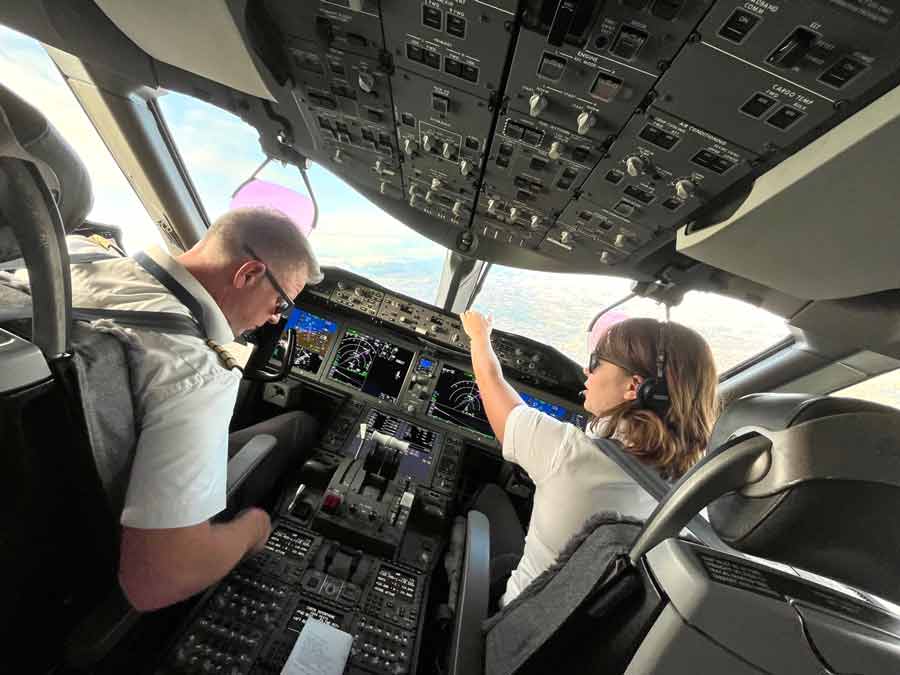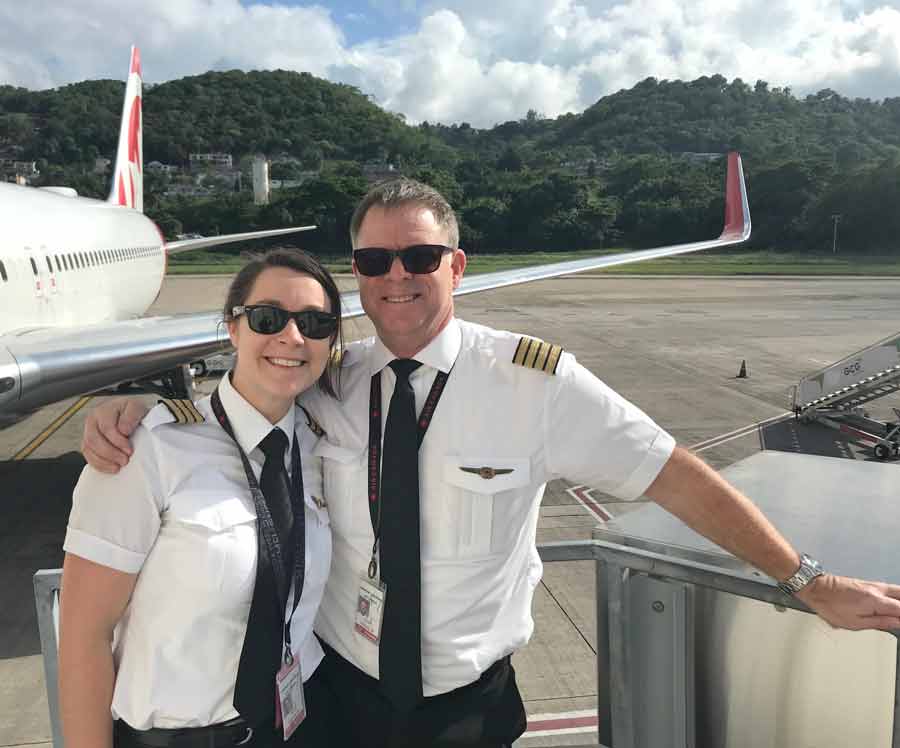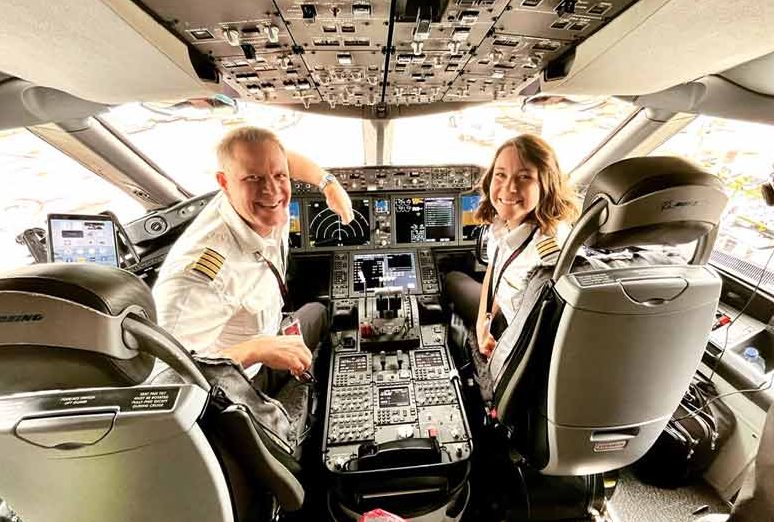CENTRE WELLINGTON – It’s not unusual for a child to follow in a parent’s footsteps as they plan their future career, and in the Marfleet household, flying runs in the family.
What is unusual is that Sarah Beiswanger will be first officer on her father Jim Marfleet’s last flight as he retires as captain for Air Canada at the end of March.
As he reflected on his career, Marfleet, of Elora, noted he too, followed in his father’s footsteps.
“My dad was a flight engineer with Ward Air,” Marfleet said, explaining the pilot and first officer would fly the plane and the engineer monitored the dials.
He said he was 10 when he accompanied his father on a flight to Honolulu.
“I sat in the flight deck and looked at what he was doing. And I kept thinking the other guys had a much nicer view,” he said, chuckling at the thought.
He was encouraged to give flying a try and while still in high school, he took private lessons at the Brampton Flying Club.
Military training
In those days, the path to becoming a commercial pilot was often through the military.
Marfleet went to Royal Military College in Kingston for basic training and continued pilot training in the summer.
He graduated in 1985 and started a jet pilot course in Moose Jaw, Saskatchewan.
There he learned to fly a CT-114 Tutor aircraft – the kind of plane the Snowbirds fly – and he even tried out to be a Snowbird, but didn’t make the cut.
He joined the 425 Tactical Fighter Squadron and flew F18s for four years.
In 1994 he left the military and got a job flying for Morningstar Air Express Inc., which delivers for FedEx Canada. There he flew a Boeing 747.
Flying with Dad
“My dad was one of their flight engineers and we flew together a few times, and it was great,” Marfleet said.
“You see your dad in a certain light and then you see him in a professional capacity,” he added, pausing over the happy memory.
In 1998 he joined Air Canada and after six-and-a-half years had worked his way to captain. Over that time, he trained on many types of planes – the CRJ (50-passenger jet), the Airbus 320, and the Boeing 767, which led to overseas flights.
Beiswanger, who now lives in Fergus, was eight years old when Marfleet started with Air Canada, and she remembers a few family vacations when her dad flew the plane.
Loving the travel
“We went on a few layovers with him – Washington, New York – and it was cool to see. It wasn’t a Monday to Friday job, and I liked that too. That’s when I got interested,” she said.
Military school was not for her though. She went to Confederation College in Thunder Bay for flight school and then spent five years flying in northern Manitoba before returning to Ontario in 2016 to fly for Air Canada Express.
After three years there, she moved to Air Canada in 2019, and because her dad was flying a Boeing 767, “I put my name in for that.”
In March of 2020, they flew together – he the captain and she first officer. But that was the beginning of the pandemic, and we all know what that did to air travel.
“The plane was retired, and I was laid off,” Beiswanger said.
“It was the first time in decades someone as young as me could hold that position on a Boeing 767 though.”
She was off work for a couple of years but is back in the first-officer seat again.

Teamwork – Marfleet showed his daughter how satisfying a career as pilot can be and she followed in his footsteps.
Marfleet said he flew more cargo planes in those early years of COVID but travel has pretty much returned to “normal.”
That can mean days and weeks away from home, overnight flights, and a lot of time trying to catch up on sleep.
“It’s a funny life – you’re all over the place and the hours are crazy. My dad saw the whole world and instilled the travel bug in me. It’s cool to see,” Beiswanger said.
Her children, aged two and five, seem to take it all in stride.
“I’m surprised how they adapt. And I do enjoy the job,” she added.
“I get a mini 24-hour vacation (on layovers) and then I’m ready to go with the kids. I think it makes me a better mom.”
Air Canada has about 5,000 pilots and about 400 are women. Is it hard operating in a man’s world?
A man’s world?
“We are definitely a minority, but I don’t think it was harder for me being a woman. It’s just a hard job and there is constant learning. You’re in training your whole career,” said Beiswanger. “But when I fly with another woman pilot, it’s definitely a blast.”
The father-daughter team is excited about their final flight together in March.
“Flying with my daughter has been amazing,” Marfleet said. “I’m very proud of her. She’s a good pilot, she’s very professional and she knows what she’s doing.”

Family flight – Sarah Beiswanger and Jim Marfleet were able to fly together a few times in the past few years before his final flight in March.
It’s a bit of an anomaly to have a parent-child pairing like this, he acknowledged.
“It took a lot of timing and luck that we are at the same company at the same time on the same plane. For me it’s a satisfying end to a satisfying career.”
His advice to young people thinking about becoming a pilot: work hard in school, especially math and physics.
“It takes time, energy and focus. Nothing lands in your lap,” he said. “But there’s lots of opportunity right now with the industry growing and boomers retiring.”
Beiswanger agreed.
“It definitely takes different skills – some of it stretched my brain to the limit,” she said.
“But flying is pretty amazing and the views – you just can’t see that any other way.
“And a good landing, that’s the best feeling in the world.”




